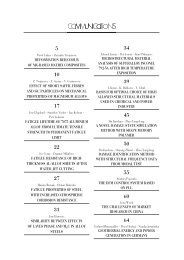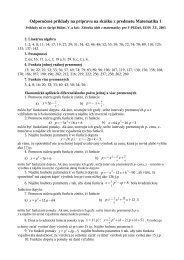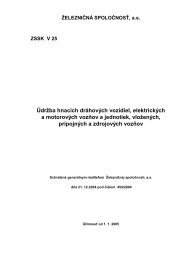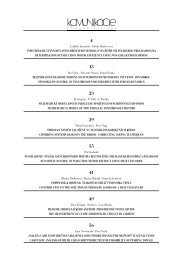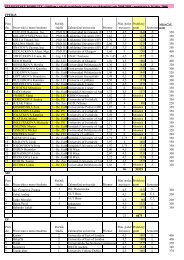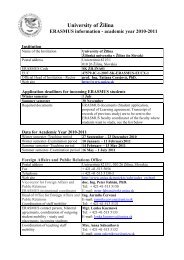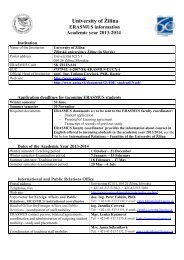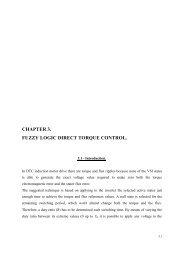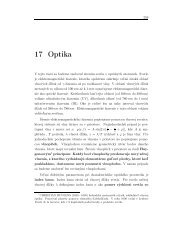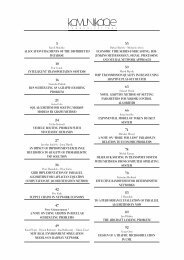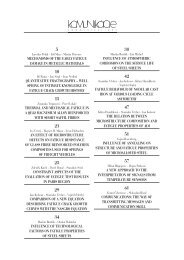simulation of torsion moment at the wheel set of the railway vehicle ...
simulation of torsion moment at the wheel set of the railway vehicle ...
simulation of torsion moment at the wheel set of the railway vehicle ...
You also want an ePaper? Increase the reach of your titles
YUMPU automatically turns print PDFs into web optimized ePapers that Google loves.
Based on Fig. 4, we can conclude th<strong>at</strong> <strong>the</strong> <strong>torsion</strong> <strong>moment</strong> <strong>of</strong><strong>the</strong> longer part <strong>of</strong> <strong>the</strong> driving shaft quite quickly rises during <strong>the</strong>slippage <strong>of</strong> <strong>the</strong> <strong>wheel</strong> <strong>set</strong>. This <strong>moment</strong> achieved <strong>the</strong> value <strong>of</strong>M t1 /M 0n 23 (M t1 6.42 MNm) in a quite short period <strong>of</strong> t 0.3 s. Consequently, <strong>the</strong> <strong>torsion</strong> <strong>moment</strong> during <strong>the</strong> slippage <strong>of</strong><strong>the</strong> <strong>wheel</strong> <strong>set</strong> will permanently impair <strong>the</strong> longer part <strong>of</strong> <strong>the</strong>driving shaft.If we curtail <strong>the</strong> value <strong>of</strong> <strong>the</strong> factor amplitude <strong>of</strong> a frequency2f 2 50 100 Hz from a 1 16/33 to a 1 0.1, <strong>the</strong> dependenceM t1 /M 0n f(t) during <strong>the</strong> slippage <strong>of</strong> <strong>the</strong> <strong>wheel</strong> <strong>set</strong> will beaccording to Fig. 5. (The factor amplitude a 1 may dwindle if weenlarge inductance <strong>of</strong> central silencer).Fig. 6 Compar<strong>at</strong>ive value <strong>of</strong> <strong>the</strong> <strong>torsion</strong> <strong>moment</strong> <strong>of</strong> <strong>the</strong> longerpart <strong>of</strong> <strong>the</strong> driving shaft <strong>at</strong> a 1 3 <strong>of</strong> a frequency2f 2 25 50 Hz during <strong>the</strong> slippage <strong>of</strong> <strong>the</strong> <strong>wheel</strong> <strong>set</strong>eject <strong>the</strong> cascade switch and simplify <strong>the</strong> traction transformer. Thissubstitute may also enable <strong>the</strong> applic<strong>at</strong>ion <strong>of</strong> recuper<strong>at</strong>ive brake.Consequently, we believe th<strong>at</strong> <strong>the</strong> modern symmetrical thyristorrectifier may elimin<strong>at</strong>e <strong>the</strong> impairing <strong>of</strong> <strong>the</strong> longer part <strong>of</strong> <strong>the</strong>driving shaft during <strong>the</strong> slippage. With this rectifier <strong>the</strong> existingantislippage shield <strong>of</strong> <strong>the</strong> ZS 441, ZS 461 and ZS 444 electrolocomotiveswill be enough speedy though now it is not.5. ConclusionFig. 5 Compar<strong>at</strong>ive value <strong>of</strong> <strong>the</strong> <strong>torsion</strong> <strong>moment</strong> <strong>of</strong> <strong>the</strong> longerpart <strong>of</strong> <strong>the</strong> driving shaft <strong>at</strong> a 1 0.1 <strong>of</strong> a frequency2f 2 50 100 Hz during <strong>the</strong> slippage <strong>of</strong> <strong>the</strong> <strong>wheel</strong> <strong>set</strong>Based on Fig 5, we can conclude th<strong>at</strong> <strong>the</strong> <strong>torsion</strong> <strong>moment</strong> <strong>at</strong>a 1 16/33 is five times smaller than <strong>the</strong> <strong>torsion</strong> <strong>moment</strong> a 1 0.1<strong>at</strong> during <strong>the</strong> slippage <strong>of</strong> <strong>the</strong> driving <strong>wheel</strong> <strong>set</strong>. The peak value <strong>of</strong><strong>the</strong> <strong>torsion</strong> <strong>moment</strong> <strong>of</strong> <strong>the</strong> longer part <strong>of</strong> <strong>the</strong> driving shaft <strong>at</strong>a 1 0.1 is <strong>at</strong>tained in t 0.25 s. Besides, our program for <strong>simul<strong>at</strong>ion</strong>showed th<strong>at</strong> <strong>the</strong> peak value <strong>of</strong> this <strong>moment</strong> fur<strong>the</strong>r dwindledwhile we were fur<strong>the</strong>r dwindling <strong>the</strong> factor amplitude <strong>of</strong>a circular frequency 2f 2 50 100 Hz.If we commute <strong>the</strong> diode or asymmetrical thyristor rectifierwith <strong>the</strong> symmetrical thyristor rectifier, we’ll receive a passablevalue <strong>of</strong> <strong>the</strong> <strong>torsion</strong> <strong>moment</strong> with <strong>the</strong> frequency 2f 2 25 50 Hz.The dependence M t1 /M 0n f(t) during <strong>the</strong> slippage <strong>of</strong> <strong>the</strong> <strong>wheel</strong><strong>set</strong> with <strong>the</strong> frequency 2f 2 25 50 Hz and a 1 3 is shownin Fig. 6.Based on Fig. 6, we can conclude th<strong>at</strong> <strong>the</strong> substitution <strong>of</strong> <strong>the</strong>diode rectifier or <strong>the</strong> asymmetrical with modern symmetrical thyristorrectifier rel<strong>at</strong>es to a passable value <strong>of</strong> <strong>the</strong> <strong>torsion</strong> <strong>moment</strong>during <strong>the</strong> slippage <strong>of</strong> <strong>the</strong> <strong>wheel</strong> <strong>set</strong>. Besides, this substitution willThe <strong>torsion</strong> <strong>moment</strong> <strong>of</strong> <strong>the</strong> longer part <strong>of</strong> <strong>the</strong> driving shaft risesquite quickly during <strong>the</strong> slippage <strong>of</strong> <strong>the</strong> <strong>wheel</strong> <strong>set</strong>. This <strong>moment</strong>was achieving <strong>the</strong> value <strong>of</strong> M t1 /M 0n 23 (M t1 6.42 MNm) inquite a short period <strong>of</strong> t 0.3 s. Consequently, <strong>torsion</strong> <strong>moment</strong>during <strong>the</strong> slippage <strong>of</strong> <strong>the</strong> <strong>wheel</strong> <strong>set</strong> will permanently impair <strong>the</strong>longer part <strong>of</strong> <strong>the</strong> driving shaft.The <strong>torsion</strong> <strong>moment</strong> <strong>of</strong> <strong>the</strong> longer part <strong>of</strong> <strong>the</strong> driving shaft <strong>at</strong>a 1 16/33 is five times smaller than <strong>the</strong> <strong>torsion</strong> <strong>moment</strong> <strong>at</strong> a 1 0.1during <strong>the</strong> slippage <strong>of</strong> <strong>the</strong> <strong>wheel</strong> <strong>set</strong>. The peak value <strong>of</strong> <strong>the</strong> <strong>torsion</strong><strong>moment</strong> <strong>of</strong> <strong>the</strong> longer part <strong>of</strong> <strong>the</strong> driving shaft <strong>at</strong> a 1 0.1 is<strong>at</strong>tained in t 0.25 s. Besides, our program for <strong>simul<strong>at</strong>ion</strong> showedth<strong>at</strong> <strong>the</strong> peak value <strong>of</strong> this <strong>moment</strong> fur<strong>the</strong>r dwindled while we werefur<strong>the</strong>r dwindling <strong>the</strong> factor amplitude <strong>of</strong> a frequency 2f 2 50 100 Hz.The substitution <strong>of</strong> <strong>the</strong> diode rectifier or <strong>the</strong> asymmetricalwith modern symmetrical thyristor rectifier rel<strong>at</strong>es to a passablevalue <strong>of</strong> <strong>the</strong> <strong>torsion</strong> <strong>moment</strong> with <strong>the</strong> frequency 2 f 2 25 50 Hz during <strong>the</strong> slippage <strong>of</strong> <strong>the</strong> <strong>wheel</strong> <strong>set</strong>. Besides, this substitutionwill eject <strong>the</strong> cascade switch and simplify <strong>the</strong> traction transformer.This substitution may also enable <strong>the</strong> applic<strong>at</strong>ion <strong>of</strong>recuper<strong>at</strong>ive brake. Consequently, we believe th<strong>at</strong> <strong>the</strong> modernsymmetrical thyristor rectifier may elimin<strong>at</strong>e <strong>the</strong> impairing <strong>of</strong> <strong>the</strong>longer part <strong>of</strong> <strong>the</strong> driving shaft during <strong>the</strong> slippage.8● COMMUNICATIONS 3/2008



